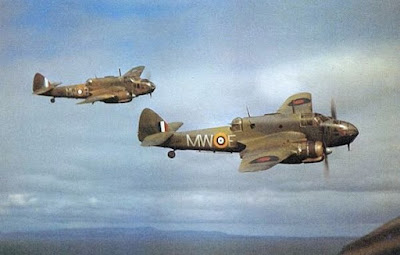This is the wartime memoir of Arthur Aldridge, an RAF pilot who flew the Bristol Beaufort torpedo bomber, although it could also carry a bomb load and mines. Attacking enemy ships in a plane as slow as the Beaufort often felt like a suicide mission to many of the pilots who flew them. This is the story of one of those courageous pilots.
The Beaufort wasn't one of the RAF's more successful designs. More were lost through accidents and mechanical failures than were lost to enemy fire. The Beaufort was adapted as a long-range heavy fighter variant called the Beaufighter, which proved to be much more successful.
Arthur Aldridge volunteered for the RAF in 1940 and spent a year in training. This included night flying, although it was so dangerous that pilots got as much 'night flying' in as they could before dark! That didn't reduce fatal accidents by much. It wasn't just confusing for the RAF. When Aldridge was based at Chivenor in Kent, a Junkers 88 landed on their runway thinking he was in the north of France. At least the RAF gained a fully functioning aircraft to test.
The first major challenge was the Channel Dash when major German surface ships broke out of Brest and sailed back to Germany. While they benefited from poor weather, it was still a comedy of errors, and the few aircraft that found the convoy did so more by luck than judgement. The Beaufort typically flew in at fifty feet and then rose to 70-80 feet to release the torpedo. Aldridge came out of the murk and saw one of the battle cruisers less than a thousand feet away. With only seconds to react, he released his torpedo. While he understandably missed, the Germans were just as surprised and didn't get much AA fire off at him. Others were not so lucky.
The craziest mission was a planned attack on the Tirpitz in Norway. The Beaufort didn't have the range to make the return trip, so they were told to fly into Sweden and hope to find an airfield or crash land into the sea. Both options meant almost certain death. This was a suicide mission, and pilots knew it. Thankfully, it was called off at the last moment when the Tirpitz slipped away using bad weather.
Aldridge and his crew were sent to Malta, where they managed to sink an Italian cruiser, the Trento. As well as a cargo ship. Flying an aircraft when everyone on Malta was on starvation rations was pretty challenging. He lost forty pounds in weight, and he wasn't big to start with. Nevertheless, he won the DFC and Bar by the age of 21. He has some interesting observations on combat stress and how the RAF did or didn't handle it. The RAF suffered 3,000 cases of nervous breakdown a year during WW2. He was an NCO and highlighted the differences between how the different pilots were treated.
There were some non-military highlights. He got to meet the cricketer Wally Hammond, a boyhood hero. Then Squadron Leader Hammond was based in Egypt. Aldridge was there en route to his final, and relatively quiet, posting in Ceylon.
In many ways, this is a typical wartime memoir, with lengthy reminiscences about training and the time spent outwith combat. They are often interesting but not that great a read. This is no different, except he flew in one of the less glamorous aircraft types. However, they do Sawyer his 95% boredom and 5% sheer terror, which is just about accurate here. He never piloted an aircraft again after the war. Who can blame him!
 |
| Bristol Beauforts of 217 Squadron |

I cannot but think that FAA pilots flying Swordfish would have regarded the description of the Beaufort as "slow" with some amusement. Despite everything the Beauforts did manage to torpedo both Lutzow and Gneisenau.
ReplyDeleteIndeed. I suspect he was making a comparison with his RAF colleagues!
DeleteThese aircrew must have been very courageous indeed. We must all remember their bravery.
ReplyDeleteKind regards,
Geoff
Flying into the combined flak of a battle cruiser and escorts must have been indescribable.
Delete